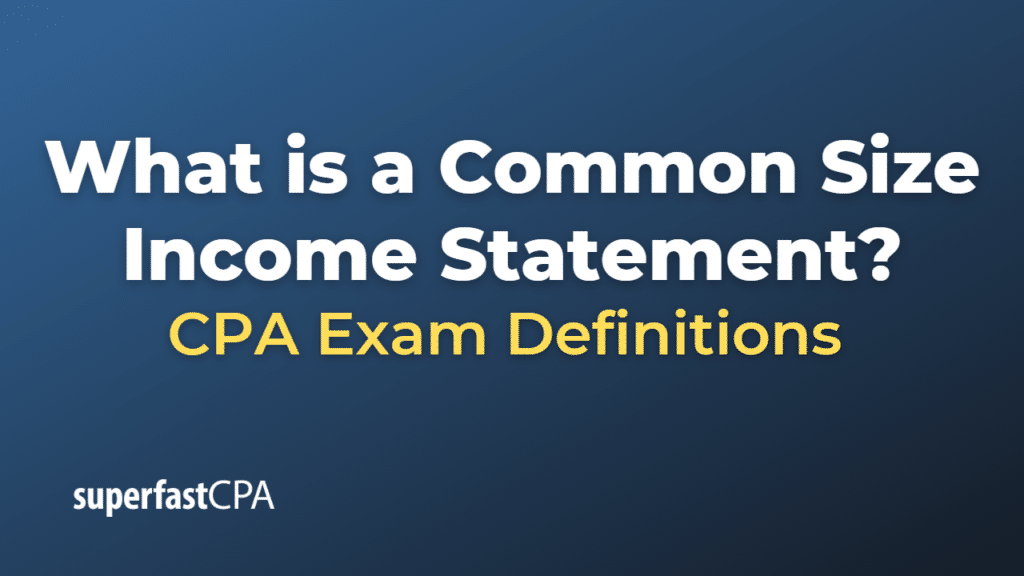Common Size Income Statement
A common size income statement is a financial statement that presents each line item on the income statement as a percentage of a common base figure, typically total revenue. This approach standardizes the income statement, making it easier to analyze and compare financial ratios and performance across different companies or time periods.
The common size income statement is particularly useful when comparing companies of different sizes within the same industry or analyzing the trends in a company’s income statement over time. It enables a more meaningful comparison by focusing on the relative proportions of various revenues, expenses, and income items, rather than their absolute values.
To create a common size income statement, each line item is divided by the total revenue and then expressed as a percentage. For example:
- Cost of Goods Sold (COGS) / Total Revenue × 100 = % of Total Revenue
- Gross Profit / Total Revenue × 100 = % of Total Revenue
- Operating Expenses / Total Revenue × 100 = % of Total Revenue
- Operating Income / Total Revenue × 100 = % of Total Revenue
- Net Income / Total Revenue × 100 = % of Total Revenue
By converting each line item into a percentage, the common size income statement allows for a more straightforward comparison of a company’s profitability and cost structure over time or with other companies in the industry. It helps in identifying trends, understanding the composition of revenues and expenses, and evaluating a company’s financial performance and efficiency.
Example of a Common Size Income Statement
Let’s consider a hypothetical example to illustrate the concept of a common size income statement for two companies, Company Alpha and Company Beta.
Here are the income statements for both companies:
Company Alpha (in thousands):
- Revenue: $1,000,000
- Cost of Goods Sold (COGS): $600,000
- Gross Profit: $400,000
- Operating Expenses: $200,000
- Operating Income: $200,000
- Interest Expense: $40,000
- Income Before Taxes: $160,000
- Income Taxes: $48,000
- Net Income: $112,000
Company Beta (in thousands):
- Revenue: $1,500,000
- Cost of Goods Sold (COGS): $1,050,000
- Gross Profit: $450,000
- Operating Expenses: $270,000
- Operating Income: $180,000
- Interest Expense: $30,000
- Income Before Taxes: $150,000
- Income Taxes: $45,000
- Net Income: $105,000
To create common size income statements for both companies, we’ll divide each line item by their respective total revenue and express the result as a percentage:
Company Alpha – Common Size Income Statement:
- Revenue: 100% (base figure)
- COGS: ($600,000 / $1,000,000) x 100 = 60%
- Gross Profit: ($400,000 / $1,000,000) x 100 = 40%
- Operating Expenses: ($200,000 / $1,000,000) x 100 = 20%
- Operating Income: ($200,000 / $1,000,000) x 100 = 20%
- Interest Expense: ($40,000 / $1,000,000) x 100 = 4%
- Income Before Taxes: ($160,000 / $1,000,000) x 100 = 16%
- Income Taxes: ($48,000 / $1,000,000) x 100 = 4.8%
- Net Income: ($112,000 / $1,000,000) x 100 = 11.2%
Company Beta – Common Size Income Statement:
- Revenue: 100% (base figure)
- COGS: ($1,050,000 / $1,500,000) x 100 = 70%
- Gross Profit: ($450,000 / $1,500,000) x 100 = 30%
- Operating Expenses: ($270,000 / $1,500,000) x 100 = 18%
- Operating Income: ($180,000 / $1,500,000) x 100 = 12%
- Interest Expense: ($30,000 / $1,500,000) x 100 = 2%
- Income Before Taxes: ($150,000 / $1,500,000) x 100 = 10%
- Income Taxes: ($45,000 / $1,500,000) x 100 = 3%
- Net Income: ($105,000 / $1,500,000) x 100 = 7%
By converting the income statements into common size format, it’s easier to compare the profitability and cost structures of both companies, regardless of their size. In this example, we can observe that Company Alpha has a lower COGS percentage, resulting in a higher gross profit margin, while Company Beta has a lower operating expenses percentage. This information can help investors, analysts, and other stakeholders better understand the companies’ financial performance and make more informed decisions.













